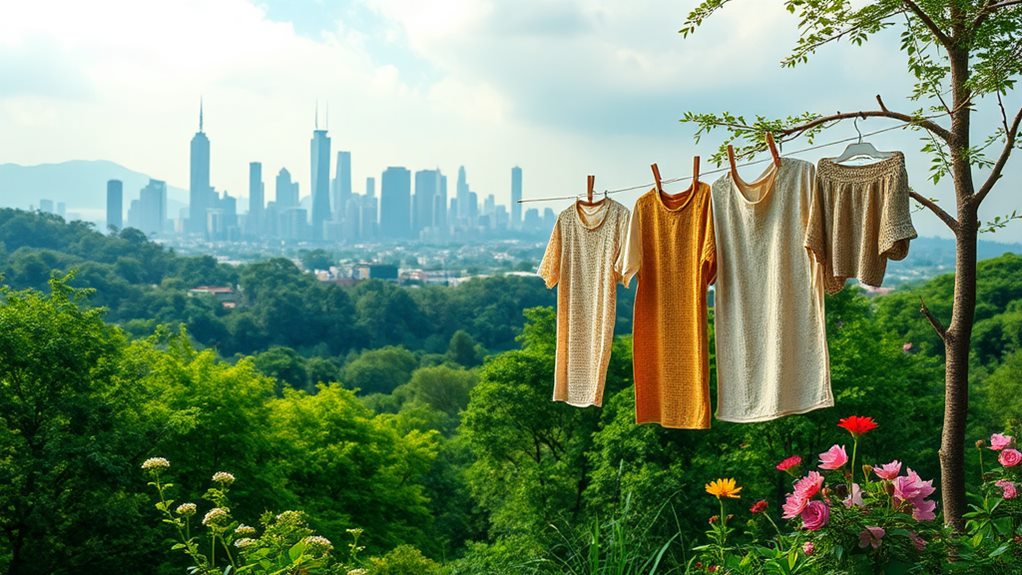Your fashion choices can greatly influence the environment. By opting for sustainable materials like organic cotton or recycled fabrics, you reduce plastic waste and energy consumption. Fast fashion's wasteful practices contribute to carbon emissions and water pollution, harming local ecosystems. Supporting ethical brands not only promotes fair labor practices but also encourages a shift towards responsible production. Engaging in waste reduction strategies, such as upcycling and recycling, can further minimize your impact. Each decision you make counts in fostering a more sustainable world. Want to explore how your actions shape the future of fashion? There's so much more to uncover.
Key Takeaways
- Ethical fashion choices reduce waste by promoting sustainable materials and circular fashion practices, minimizing the environmental impact of textile production.
- Opting for organic cotton and recycled fabrics decreases reliance on synthetic fibers, which take centuries to decompose and contribute to plastic pollution.
- Supporting fair trade brands ensures ethical labor practices, empowering workers while fostering communities and reducing exploitation in the fashion industry.
- Conscious consumerism encourages brands to adopt eco-friendly practices, leading to innovative solutions that prioritize sustainability and reduce carbon footprints.
- Eco-friendly certifications help consumers identify responsible brands, promoting transparency and encouraging sustainable production methods that protect ecosystems and local communities.
The Cost of Fast Fashion
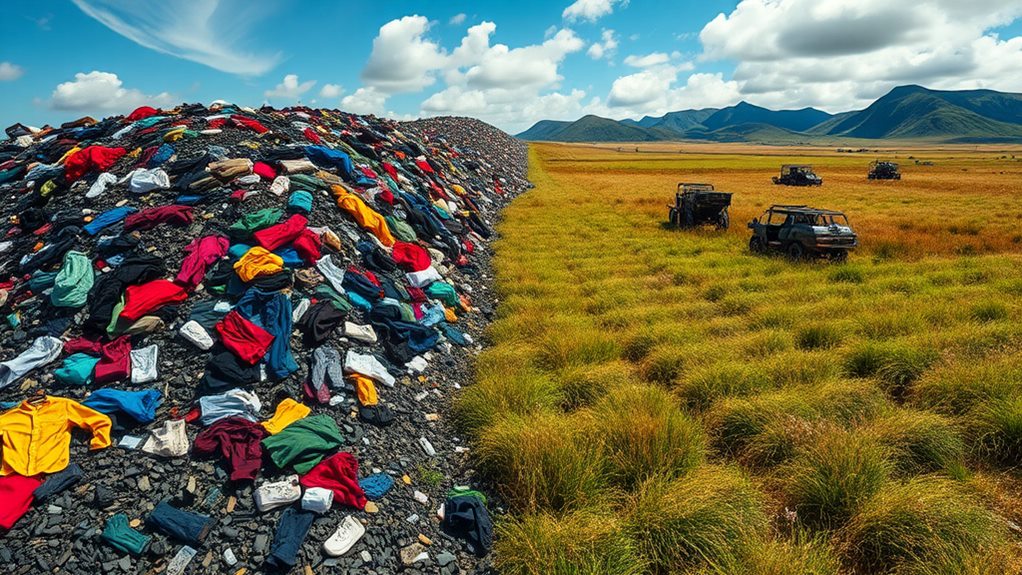
Fast fashion regularly entices consumers with its trendy designs and low prices, but the true cost extends far beyond your wallet. Each time you buy an inexpensive, stylish outfit, you mightn't realize the environmental impact your purchase creates. Fast fashion contributes to massive waste, with millions of tons of clothing ending up in landfills every year. These garments often contain synthetic fibers that take centuries to decompose, releasing harmful chemicals into the soil and water as they break down.
The production process of fast fashion is energy-intensive and heavily reliant on water. Did you know it can take up to 2,700 liters of water to make just one cotton shirt? That's enough water for one person to drink for two and a half years! This unsustainable demand strains our planet's resources and contributes to pollution, harming ecosystems and wildlife. By contrast, opting for sustainable alternatives, such as reusable produce bags, can greatly reduce plastic waste and promote a more eco-friendly lifestyle.
You might be wondering if there's a way to make a difference while still feeling stylish. The good news is, there are sustainable alternatives. By choosing brands that prioritize eco-friendly practices, you can express your personal style without compromising the environment. Thrift shopping, swapping clothes with friends, or investing in high-quality, timeless pieces are also great ways to support a more sustainable fashion landscape.
Next time you're tempted by a trendy item, consider its broader impact. Your choices can help foster a fashion culture that values both style and sustainability, allowing you to belong to a community that cares about our planet's future.
Benefits of Sustainable Materials

Embracing sustainable materials in fashion not only benefits the environment but also enhances your wardrobe with quality and longevity. When you choose eco-friendly alternatives, you're making a statement about your values and your commitment to a better world. Sustainable materials, such as organic cotton, hemp, and recycled fabrics, offer innovative solutions that reduce waste and minimize your carbon footprint.
For instance, organic cotton t-shirts, which are made from 100% certified organic cotton, provide exceptional softness and breathability while supporting eco-friendly farming practices environmental impact considerations.
You might be surprised to learn about the strides made in material innovation. Brands are now creating textiles that aren't only stylish but also environmentally responsible. Think about how good it feels to wear a dress made from Tencel, derived from sustainably sourced wood pulp. Not only does it feel luxurious against your skin, but it also decomposes naturally, leaving no harmful residues behind.
Additionally, opting for sustainable materials often means investing in higher quality pieces that stand the test of time. Fast fashion items may tempt you with low prices, but they often wear out quickly, leading to more waste. When you choose sustainable options, you're likely to find garments that maintain their shape, color, and style even after multiple washes.
In a world that increasingly values authenticity and responsibility, your fashion choices can reflect who you are. By embracing sustainable materials, you not only elevate your wardrobe but also become part of a community that cares about the planet. Let your wardrobe choices resonate with your commitment to sustainability, and inspire others to follow your lead.
Water Usage in Fashion Production
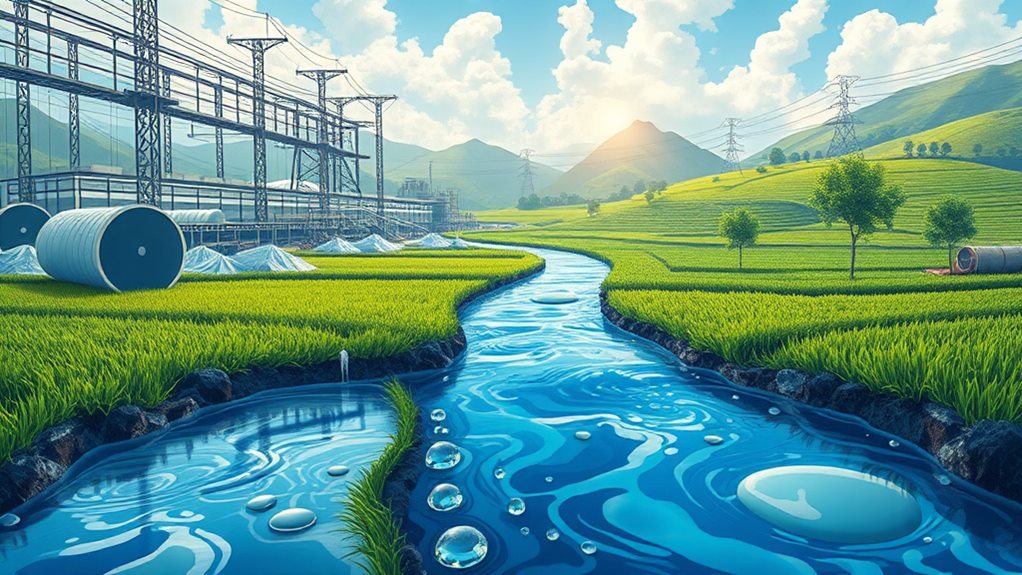
While sustainable materials provide a great foundation for eco-friendly fashion, another significant issue looms large in the industry: water usage in fashion production. You might be surprised to learn just how much water it takes to create the clothes you wear. From cotton cultivation to textile dyeing, the fashion industry consumes an astonishing amount of this precious resource.
Eco-friendly certifications can help guide consumers towards brands that prioritize sustainability in their production processes.
Cotton, often praised for its versatility, requires an average of 7,000 liters of water to produce just one kilogram of fabric. This massive demand can lead to water scarcity in regions where it's grown, impacting local communities and ecosystems. Imagine the communities that rely on these water sources for drinking, cooking, and farming—your fashion choices can directly affect their access to clean water.
When it comes to textile dyeing, the situation doesn't get any better. This process not only uses vast amounts of water but also introduces harmful chemicals into waterways, threatening aquatic life and human health. The vibrant colors in your favorite garments come at a cost, often leaving a toxic legacy behind.
Carbon Footprint of Clothing

Many people overlook the carbon footprint of their clothing, yet it plays a crucial role in understanding the environmental impact of fashion. Every time you purchase a piece of clothing, it's vital to ponder how it was made and what materials were used. The production process, from raw materials to finished garments, can release a remarkable amount of carbon dioxide into the atmosphere.
By choosing brands that focus on sustainable manufacturing and use eco-friendly textiles, you can help diminish this footprint. Here's a quick comparison to illustrate the differences:
| Clothing Type | Carbon Footprint (kg CO2) | Eco-Friendly Option |
|---|---|---|
| Conventional Cotton | 2.2 | Organic Cotton (1.1) |
| Polyester | 5.0 | Recycled Polyester (3.5) |
| Leather | 12.0 | Vegetable-Tanned Leather (8.0) |
| Wool | 6.0 | Merino Wool (4.0) |
As you can see, opting for eco-friendly alternatives can greatly lower the carbon emissions associated with your wardrobe. Every choice you make sends a message about the kind of world you want to support. Reflect on the impact of your clothing on the environment and embrace fashion that respects the planet. By making informed choices, you not only contribute to a healthier Earth but also foster a sense of belonging to a community that values sustainability. Together, we can make a difference, one garment at a time.
Ethical Labor Practices

The impact of your clothing choices extends beyond just carbon emissions; ethical labor practices in the fashion industry play a significant role in promoting a more sustainable and responsible approach to fashion. When you choose brands that prioritize fair trade, you're not just investing in stylish garments; you're supporting a system that values and protects worker rights. This means fair wages, safe working conditions, and the empowerment of workers in the supply chain.
As you shop, consider the stories behind your clothes. Each piece can represent a commitment to ethical labor practices. Brands that engage in fair trade guarantee that workers receive a fair price for their labor, which can uplift entire communities. When you buy from these brands, you're not only making a fashion statement; you're participating in a movement that advocates for social justice and economic equity.
You might wonder how to identify these ethical brands. Look for certifications or labels that indicate fair trade practices. Research the companies you support and see if they disclose their labor practices. Engaging with brands that uphold ethical standards fosters a sense of belonging to a community that values integrity and compassion.
Your clothing choices can drive significant change. By prioritizing ethical labor practices, you contribute to a fashion industry that respects its workers, promotes fair trade, and ultimately creates a more sustainable environment for everyone involved. Each purchase sends a message: you care about the people behind your clothes.
Waste Reduction Strategies
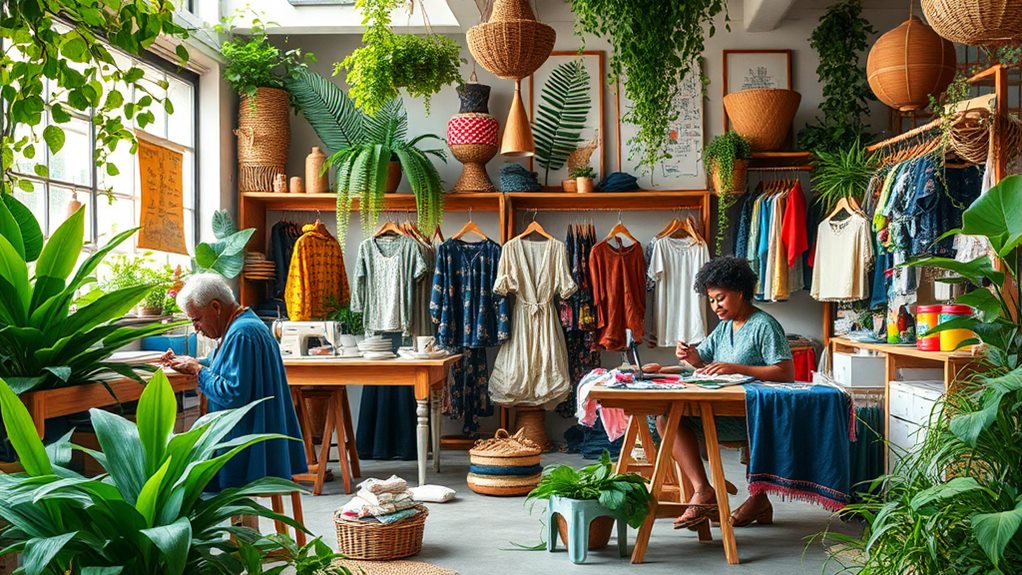
A staggering amount of clothing ends up in landfills each year, contributing to a growing waste crisis in the fashion industry. But you can be part of the solution by embracing waste reduction strategies that not only help the planet but also foster a sense of belonging within your community.
Consider participating in upcycling initiatives. These projects transform old garments into something fresh and stylish, allowing you to express your creativity while reducing waste. You'll find that many local workshops or online communities invite you to join in, sharing tips on how to breathe new life into your wardrobe.
Recycling programs are another way to make a difference. Many brands now offer take-back schemes, where you can return your unwanted clothes for recycling or repurposing. By supporting these programs, you help ensure that textiles don't end up in landfills, and you're encouraging companies to adopt more sustainable practices.
Additionally, think about your purchasing habits. Opt for brands that use sustainable packaging and eco-friendly alternatives. This not only minimizes waste but also demonstrates your support for companies committed to the environment. Your choices can drive change, inspiring others to follow suit.
Circular Fashion Economy

Embracing the principles of a circular fashion economy can fundamentally reshape your relationship with clothing and its impact on the planet. By focusing on closed-loop systems, you can contribute to a more sustainable future where fashion doesn't just end up in landfills. Instead of discarding old garments, you can actively participate in textile recycling, ensuring that materials are reused and repurposed.
Imagine a world where fashion thrives on creativity and responsibility, where:
- Upcycled fashion transforms discarded pieces into trendy, unique items that reflect your personal style.
- Waste reduction becomes a collective goal, uniting you with others who share a passion for sustainability.
- Community exchanges allow you to trade and share clothes, fostering a sense of belonging while minimizing waste.
In a circular fashion economy, every piece of clothing tells a story. When you choose upcycled or recycled materials, you're not just making a purchase; you're making a statement about your values. This approach not only reduces textile waste but also encourages brands to innovate and create responsibly.
Consumer Influence on Trends
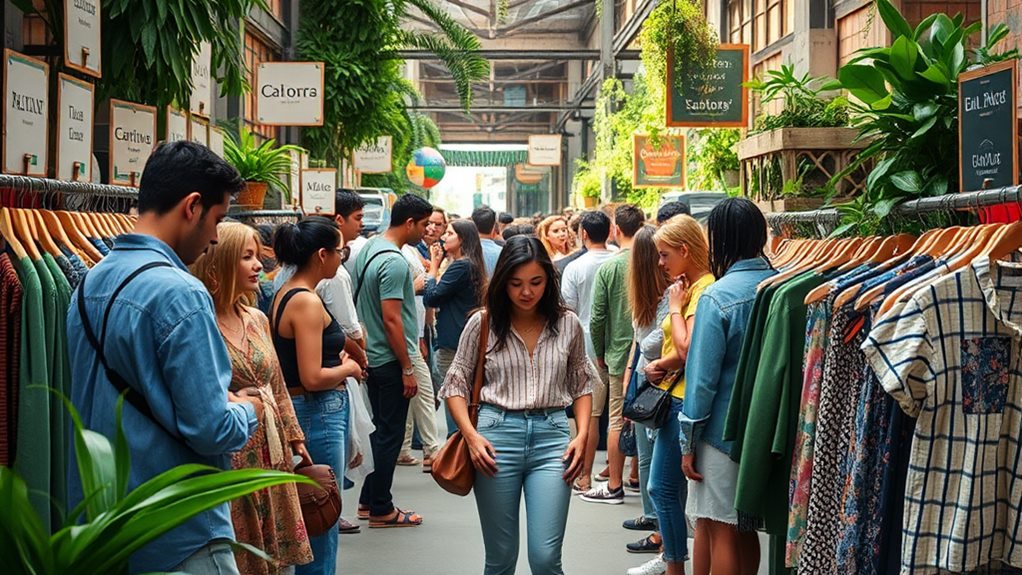
Through your purchasing decisions and social media interactions, you hold significant power to shape fashion trends. When you choose to buy from brands that prioritize ethical practices, you send a strong message about what matters to you. Your voice, amplified through platforms like Instagram and TikTok, influences others, creating a ripple effect that can redefine the standards of style and sustainability.
As a conscious consumer, you can challenge harmful practices, such as cultural appropriation, by supporting designers who respect and celebrate cultural heritage rather than exploit it. By sharing your favorite ethical brands and their stories, you're not just promoting fashion; you're fostering an inclusive community that values diversity and creativity.
Moreover, your commitment to social responsibility can inspire friends and followers to rethink their choices. When you showcase your outfits made from sustainable materials or thrifted finds, you encourage a shift away from fast fashion, which often leads to environmental degradation and labor exploitation.
Your influence doesn't stop at your wardrobe; it extends to how brands operate. As more consumers demand transparency and ethical practices, companies will be compelled to adapt. You're part of a movement that challenges the status quo, promoting trends that prioritize people and the planet over profit.
Frequently Asked Questions
How Can I Identify Truly Ethical Fashion Brands?
To identify truly ethical fashion brands, you'll want to look for brand transparency and responsible material sourcing. Check if they openly share their production processes and labor practices; this shows a commitment to ethical standards.
Research the materials they use—opt for brands that prioritize sustainable fibers and avoid harmful chemicals. Engaging with brands that align with your values not only elevates your style but also connects you with a community that cares about ethical practices.
Are There Certifications for Sustainable Fashion?
When it comes to sustainable fashion, you're not just barking up the wrong tree—there are indeed certification standards out there!
Look for labels like GOTS or Fair Trade, which promote industry transparency and ethical practices. These certifications help you identify brands that align with your values, ensuring your choices make a positive impact.
What Role Does Consumer Education Play in Ethical Fashion?
Consumer education plays an essential role in ethical fashion by shaping your consumer behavior. When you understand sustainable practices, you're more likely to choose brands that prioritize ethics over fast fashion. This knowledge empowers you to make informed choices, fostering a sense of belonging in a community that values sustainability.
How Do Fashion Trends Contribute to Environmental Harm?
When it comes to fashion, what you might call "rapidly evolving styles" often leads to more than just closet clutter. Fast fashion's charm can mask its pollution impact, as quick production cycles generate waste and harmful emissions.
You're part of a community that loves expressing individuality, but choosing trendy pieces could mean contributing to environmental harm. Embracing timeless styles instead can help you belong, all while making a positive difference for our planet.
Can Second-Hand Clothing Be Considered Ethical?
Absolutely, second-hand clothing can be considered ethical! By choosing pre-loved items, you're actively participating in a circular economy that reduces waste and lessens the environmental impact of fashion. Each piece you buy extends its life, minimizing the need for new production and the resources it consumes.
Plus, you're supporting local thrift stores and charities, fostering a sense of community. So, when you wear those vintage finds, you're making a stylish, conscious choice!
Conclusion
When you choose ethical fashion, you're not just making a style statement; you're making a powerful impact on the planet. Some might argue that sustainable options are too expensive, but consider this: investing in quality pieces means you're supporting a healthier environment and fair labor practices. Every conscious choice contributes to a brighter future for our planet. Remember, your wardrobe can be a force for good—so let's wear our values and inspire change together!

